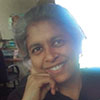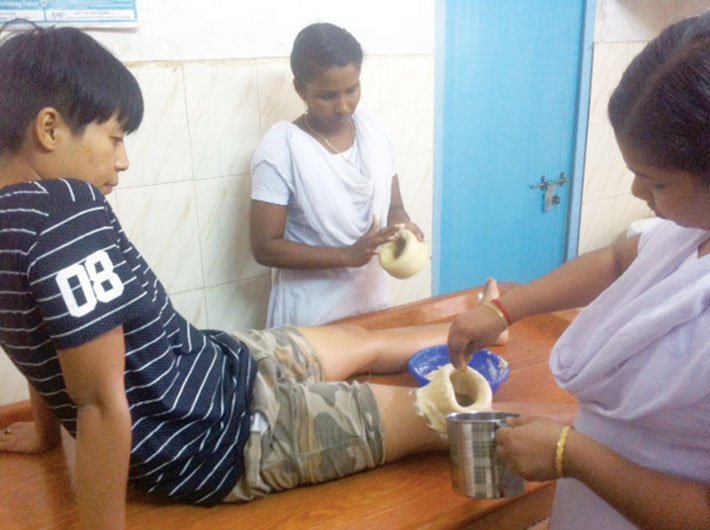Bijeta Devi, a footballer from Manipur who has been working and playing for the Indian railways, has been out of action for the last six months because of a nagging pain in her knee. She traces the pain to a game six years ago, during which the ball hit her knee. “Since then, I have been to several doctors and taken medicines. While I was able to play, the pain never left me,” she says.
Bijeta Devi is now undergoing treatment at the sports ayurveda unit of the Rama Verma District Ayurveda Hospital in Thrissur, where many sportspersons have obtained positive results. As she speaks to us, two nurses pasted a dough of ground pulses around her knees till they resembled two bowls. Then they began to pour a dark oil into the cups as she sat with her knees raised on a wooden bed. Her doctor Sheeba explained that the process would ensure a complete cure and she’d be fit to play when she leaves the hospital in two weeks.
Other district ayurveda hospitals in Kerala have started similar clinics for treatment of sports injuries and the clinics are popular with sportspersons from across the country seeking treatment for injuries and trauma.
In another room at the Rama Verma hospital, an athlete lay on her tummy, wincing with a bad shoulder pain. The doctor rotates a cup-like instrument on the affected area. It sucks up the flesh. She then uses the tip of a surgical knife to make several pricks on the marked, raised area. The cup is put back on the area, and blood and pus fills up in the cup in the next few minutes while the patient waits quietly. Soon, the nurses remove the cup, wipe the patient’s back clean and she is ready to go. “I felt the pain go along with the blood. What remained was just the slight pain of the pricking,” she says later.
Rashmi K, a champion javeline thrower of Western Railways, recalls how she also underwent the same procedure for her shoulder pain. “The pain of the procedure is nothing,” she says. “I felt almost instant relief after undergoing it.” Her doctor, Bimal CK, says the procedure is called prachanam, and is one of the strategies used to remove pain and inflamation.
Rashmi was made to rest for three days, after which she was treated with a kizhi, or poultice, a cloth bundle stuffed with herbs and medication which varies according to the needs of the patient. Sometimes, it is powdered pulses, sometimes medicated lemon, sometimes certain grains. For Rashmi, the kizhi was stuffed with lemon pieces cooked in medicine. The kizhi is heated and applied in quick movements on the affected area. The procedure is repeated several times daily for many days, while some medicine is given for internal consumption, says Dr Sheeba. Rashmi is set to resume practice for the next railways event in February. “I won for Western Railways in 2016 and 2017 despite severe pain. Now I will throw without pain,” she says. On the last day of her 18-day stay, she was all smiles, distributing sweets to her doctors and nurses.
Big plans
Prime minister Narendra Modi recently said he wanted an ayurveda hospital in every district of the country. That may be a distant goal, as hospitals require trained personnel and there aren’t enough of them. But in Kerala, there is a strong tradition of ayurveda and it is popular too, so trained doctors, physiotherapists and paramedics are available. So much so, there are panchayat-level dispensaries run by the state government’s department of Indian systems of medicine. Soon, ayurvedic treatment may be offered at primary health centres. District hospitals – such as the Rama Verma hospital in Thrissur – already offer ayurvedic treatment. Sports ayurveda is another specialisation that the Kerala government has been promoting.
Ayurveda, as is well known, is an ancient Indian system of medicine that chiefly uses herbs to work cures. Treatment is based on ancient texts such as Sushruta Samhita and Ashtangahridayam. The Kerala government has been promoting ayurveda specialisations in its hospitals that are based on the eight sections in the Ashtangahridayam. “We will have bala chikitsa (paediatrics), kaya chikitsa (internal medicine), manasika arogyam (psychiatry), marma chikitsa (treatment by application of pressure at specific body points), urdhanga chikits (ENT and ophthalmology), shalya tantram (surgery), visha chikitsa (treatment for poisoning), rasayana chikitsa (rejuvenation), geriatrics and obstetrics. Every medical need can be taken care of as we will have specialists in all these departments.,” says Dr Sheela Karlam, district medical officer (Ayush) for Thrissur district, who presides over three district hospitals and many panchayat-level dispensaries.
One of the district hospitals, in Chelakkara, is known throughout the state for kshaara sutra chikitsa (or treatment of piles and fissures): more than 3,000 cases are handled by the hospital every year. “And,” says Dr Karlam, “if one were to take old and new cases for 2016-17, it is handling 9,075 cases. This hospital has become a model for the entire state.” She offers its example to emphasise the potential of ayurveda to deal with various medical conditions, including sports injuries.
How effective?
VN Gopinathan, a retired joint director of the state Ayush department, was one of the officials who promoted sports ayurveda. Asked if ayurveda is suited to the treatment of sports injuries, he says government-run hospitals treat such injuries using modern medicine in combination with ayurveda. “Since the patients are sportspersons, we avoid giving internal medicines to avoid complications like doping charges,” he says. “But the best techniques of ayurveda are used. Doctors use some oils that are very effective. Some of these oils are used as sprays, as in modern medicine.”
Many ayurveda doctors from Kerala were first trained in the use of modern medical methods two years before the Commonwealth Games in Delhi at an exchange programme with doctors of the Maulana Azad Medical College Hospital in the capital. Already, the Sports Authority of India is using such combined treatment in all its Kerala units. And a hospital dedicated just to sports ayurveda is coming up in Thrissur district.
Dr Jayan, who heads the sports ayurveda department in Thiruvananthapuram, says it is for the first time doctors have used ayurveda for preventive, theraupeutic and rehabilitation purposes with sportspersons. Under preventive care, sportspersons are given massages and food supplements like gooseberries and ashwagandha. Ayurveda looks at food itself as a medicine.
“We have been dealing with case after case of different kinds of sports injuries and it has been a tremendous success. We have been documenting these cases and will be presenting it to the rest of the world. But as of now, the Kerala government has not allotted funds for research in this area,” he says. Like Gopinath, he vouches for the efficacy of ayurveda for sportspersons: he says ayurveda has been used for injury management for 5,000 years; it’s only being adapted now for sports injuries.
Once the new hospital comes up, the sports unit at the Rama Verma hospital will move in there. Dr CK Bimal, head of the unit, recalls one of his success stories. A woman weightlifting champion from a local college had injured a ligament and was advised surgery. He suggested that she might try out four weeks’ ayurvedic treatment. She agreed, was able to forgo surgery, and went on to be a university champion. The news was all over the media.
Dr Bimal turned to sports ayurveda after training at the Maulana Azad Medical College Hospital in Delhi before the Commonwealth Games. Besides, he did courses in marma and siddha; also a sports medicine course from Apollo Hospital.
Record-breaker’s delight
Renjith Maheshwari, who holds the triple jump national record at 17.3 metres (July 2016, Bengaluru), had a bad bout of excruciating back pain in 2014. He credits the National Games gold he won the next year to the ayurvedic treatment he received at the Rama Verma hospital. “That was the second turning point in my career as a sports medicine specialist,” says Dr Bimal.
Why do ayurveda doctors go for sports medicine? Says Bimal, “It is out of a sense of service. Most of these sportspersons are economically weak and yet bring glory to our nation. If I am able to help them, it is a great thing for me. When these players win gold, they often call me up before calling up even their parents! What more do I need!”
Krishnendu, a volleyball player from Kerala, was discharged from the sports unit at Thrissur after a 15-day stay in October this year. She had acute spondilitis and could not move her neck. The treatment cured her completely. She says, “This was my second experience there. Earler, I had gone there with a shoulder pain and they used techniques that gave me relief from pain. But after this attack of cervical spondilitis, I had considered quitting the course in physical training that I was doing. Now I am going back to my BEPT course.”
Ayurvedic texts dont have any specific methods for sports. In fact sports injuries are a modern demand. Dr Bimal says that marma, which deals with energy points in the body and is as ancient as kalaripayattu, the Kerala martial art, helps in dealing with problems not usually seen in non-sportspersons. It is a pain relieving technique which uses human touch on vital points in the body to help healing.
“Ayurveda has been there for centuries but that does not make it irrelevant. We can see its efficacy when we know how to craft it according to our needs,” he says.”Everything is given in the texts. But most of the time, ayurvedic doctors don’t know where to use the solutions given in these texts.” He takes an hour or so to talk to patients and find out the problem they face; after that, he sits down with Dr Sheeba so that they can decide on the course of treatment together.
In countries like China, Korea, and the Carribean islands, with ancient traditions of indigenous medicine, sportspersons often turn to traditional methods of dealing with injury and for rest and recuperation. These traditional systems command much respect. Ayurveda, too, has a strong following. By combining with modern methods, it hopes to change with the times and address itself to the needs of the times.
feedback@governancenow.com
(The article appears in the December 31, 2017 issue)

